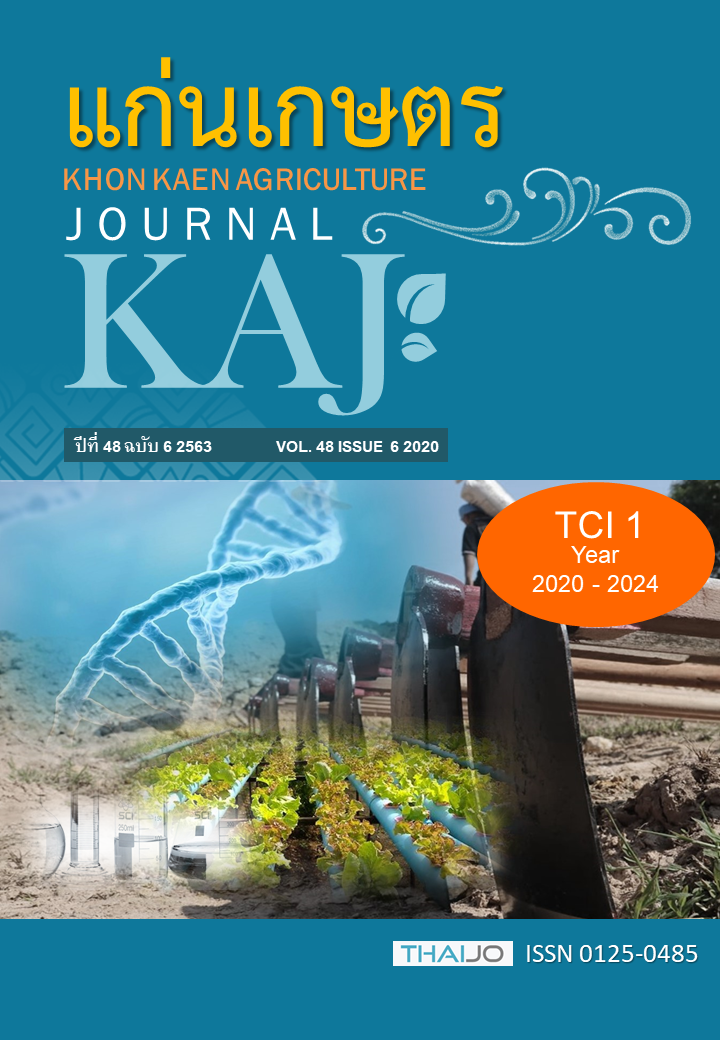การพัฒนาวิธีการตรวจหาเชื้อ Leifsonia xyli subsp. xyli สาเหตุโรคตอแคระแกร็นของอ้อยด้วยเทคนิค Quantitative polymerase chain reaction - high resolution melting analysis (qPCR-HRM)
Main Article Content
บทคัดย่อ
โรคตอแคระแกร็นของอ้อย (ratoon stunting disease of sugarcane; RSD) ที่เกิดจากเชื้อแบคทีเรีย Leifsonia xyli subsp. xyli (LXX) ทำให้ต้นอ้อยแคระแกร็น ไม่ย่างปล้อง ทำให้ผลผลิตอ้อยลดลงได้ 5-30% และถึง 50% ในอ้อยพันธุ์อ่อนแอ อ้อยที่ติดเชื้อนี้อาจไม่แสดงอาการของโรคหรือแสดงอาการที่ไม่ชัดเจนทำให้เกิดความสับสนกับโรคหรือสาเหตุอื่น ๆ ที่ยากต่อการวินิจฉัยโรคนี้ในแปลงปลูก จึงต้องใช้วิธีตรวจหาเชื้อสาเหตุที่มีความแม่นยำและมีความไวในการตรวจสูง การศึกษานี้มีวัตถุประสงค์เพื่อพัฒนาวิธีตรวจหาเชื้อ LXX ในตัวอย่างอ้อยด้วยเทคนิค quantitative polymerase chain reaction ร่วมกับ high resolution melting analysis (qPCR-HRM) ซึ่งใช้หลักการของ qPCR ร่วมกับการวิเคราะห์ค่า melt peak ของผลผลิตจาก qPCR โดยเก็บตัวอย่างอ้อยจากสถานีผสมพันธุ์อ้อยบ้านทิพุเย กาญจนบุรี และศูนย์วิจัยพืชไร่สุพรรณบุรี จำนวนรวม 240 ตัวอย่าง สกัดจีโนมิกส์ดีเอ็นเอ (gDNA) จากอ้อยและนำมาใช้เปรียบเทียบการตรวจหาเชื้อ LXX ด้วยเทคนิค conventional PCR และ qPCR-HRM พบว่าเทคนิค conventional PCR ที่ใช้คู่ไพรเมอร์ Pat1-F2/Pat1-R2 ที่จำเพาะกับยีน Pat1 และ CxxITSf#5/CxxITSr#5 ที่จำเพาะกับบริเวณ 16S-23S DNA internal transcribed spacer (ITS) ของเชื้อ LXX ให้ผลตรวจพบเชื้อได้ 29 และ 61 ตัวอย่างตามลำดับ เทคนิค qPCR-HRM ที่ใช้คู่ไพรเมอร์ LayF/LayS ที่จำเพาะกับบริเวณ ITS ของเชื้อในจีนัส Leifsonia ให้ผลในการตรวจพบเชื้อ LXX จำนวน 96 ตัวอย่าง ดีกว่าวิธีข้างต้น การทวนสอบความถูกต้อง (verification) ของเทคนิค qPCR-HRM ในการตรวจหาเชื้อ พบว่าผลผลิต qPCR-HRM มีค่า melt peak ที่อุณหภูมิ 83.6 ºC ที่ตรงกับจากของเชื้อ LXX ที่มีรายงานไว้และตรวจสอบความใช้ได้ (validation) ของวิธีการโดยการวิเคราะห์ลำดับนิวคลีโอไทด์บริเวณ ITS ขนาด 606 bp พบว่ามีลำดับนิวคลีโอไทด์ที่เหมือนกับ ITS ของเชื้อ LXX จากฐานข้อมูล GenBank ทั้งหมด (100%) ผลการศึกษาทำให้สรุปได้ว่าเทคนิค qPCR-HRM เป็นวิธีการตรวจหาเชื้อ LXX ที่สามารถตรวจหาเชื้อในสภาวะที่มีปริมาณต่ำ ๆ (sensitive) เและมีความแม่นยำสูง
Article Details
References
Aljanbi, S.M., L. Forget, and A. Dookun. 1999. An improved and rapid protocol for the isolation of polysaccharide and polyphenol-free sugarcane DNA. Plant Mol. Biol. 17: 1–8.
Bradbury J.F. 1986. Guide to Plant Pathogenic Bacteria. CAB International Mycological Institute, Wallingford.
Evtushenko, L.I., L.V. Dorofeeva, S.A. Subbotin, J.R. Cole, and J.M. Tiedje. 2000. Leifsonia poae gen. nov., sp. nov., isolated from nematode galls on Poa annua, and reclassification of ‘Corynebacterium aquaticum’ Leifson 1962 as Leifsonia aquatica (ex Leifson 1962) gen. nov., nom. rev., comb. nov. and Clavibacter xyli Davis et al. 1984 with two subspecies as Leifsonia xyli (Davis et al. 1984) gen. nov., comb. nov. Int. J. Syst. Evol. MicR. 50: 371-380.
Falloon, T., E. Henry, M.J. Davis, E. Fernandez, J.C. Girard, P. Rott, and J.H. Daugrois. 2006. First report of Leifsonia xyli subsp. xyli causal agent of ratoon stunting of sugarcane in Jamaica. Available: https://doi.org/10.1094/PD-90-0245B. Accessed Feb.21, 2019.
Fegan, M., B.J. Croft, D.S. Teakle, A.C. Hayward, and G.R. Smith. 1998. Sensitive and specific detection of Clavibacter xyli subsp. xyli, causal agent of ratoon stunting disease of sugarcane with a polymerase chain reaction based assay. Plant Pathol. 47: 495–504.
Fu, H.Y., S.R. Sun, J.D. Wang, K. Ahmad, H.B. Wang, R.K. Chen, and S.J. Gao. 2016. Rapid and quantitative detection of Leifsonia xyli subsp. xyli in sugarcane stalk juice using a real-time fluorescent (TaqMan) PCR assay. Biomed Res. Int. Article ID 2681816. Available: https://www.hindawi.com/journals/bmri/
2016/2681816/. Accessed Nov.14, 2019.
Grisham, M.P., Y.-B. Pan, and E.P. Jr Richard. 2007. Early detection of Leifsonia xyli subsp. xyli in sugarcane leaves by real-time polymerase chain reaction. Plant Dis. 91: 430-434.
Kumar, S., G. Stecher, and K.Tamura. 2016. MEGA7: Molecular evolutionary genetics analysis version 7.0 for bigger datasets. Mol. Biol. Evol. 33: 1870–1874.
Lee, M.S., T.Y. Su, Y.Y. Lien, and S.C. Sheu. 2017. The development of loop-mediated isothermal amplification (LAMP) assays for the rapid authentication of five forbidden vegetables in strict vegetarian diets. Available: https://www.nature.com/articles/srep44238.pdf. Accessed Nov.14, 2019.
Liu, J., L.P. Xu, J.L. Guo, R.K. Chen, M.P. Grisham, and Y.X. Que. 2013. Development of loop-mediated isothermal amplification for detection of Leifsonia xyli subsp. xyli in sugarcane. Biomed Res. Int. Article ID 357692. Available: https://www.hindawi.com/journals/bmri/2013/357692/. Accessed May.17, 2019.
Nicholas, K.B., H.B. Nicholas, and D.W. Deerfield. 1997. GeneDoc: Analysis and Visualization of Genetic Variation. EMBNEW.NEWS 4:14. Available: https://www.scienceopen.com/document?vid=fef1e5ea-46ec-4711-a8ad-e83537a49429. Accessed Jan.9, 2020.
Pelosi C.S., M.V. Lourenço, M. Silva, A.Z. Santos, S.C. França, and M. Marins. 2013. Development of a Taqman real-time PCR assay for detection of Leifsonia xyli subsp xyli. Tropical Plant Pathol. 38: 343-345.
Sun, S.R, J.L.Chen, Y.Y. Duan, N. Chu, M.T. Huang, H.Y.Fu, and S.J.Gao. 2019. Improved primers for the specific detection of Leifsonia xyli subsp. xyli in sugarcane using a conventional PCR assay. Plant Dis. 103: 3251-3258.
Wu Q.B., Y.B. Pan, D.G. Zhon, M.P. Grisham, S.W. Gao, Y.C. Su, J.L. Guo, L.P. Xu, and Y.X. Que. 2018.A comparative study of three detection techniques for Leifsonia xyli subsp. xyli, the causal pathogen of sugarcane ratoon stunting disease. Biomed Res. Int. Article ID 2786458. Available: https://www.hindawi.com/journals/bmri/2018/2786458/. Accessed Sep.21, 2019.
Young, A.J. 2017. Validation of LSB-PCR diagnostic for ratoon stunting disease and characterisation of non-Lxx strains of Leifsonia associated with sugarcane: final report 2014/086. Available: https://elibrary. sugarresearch.com.au/handle/11079/16949. Accessed Aug.18, 2019.
Young, A.J., and C.J. Nock. 2017. Molecular detection of diverse Leifsonia strains associated with sugarcane. Plant Dis. 101: 1422-1431.

